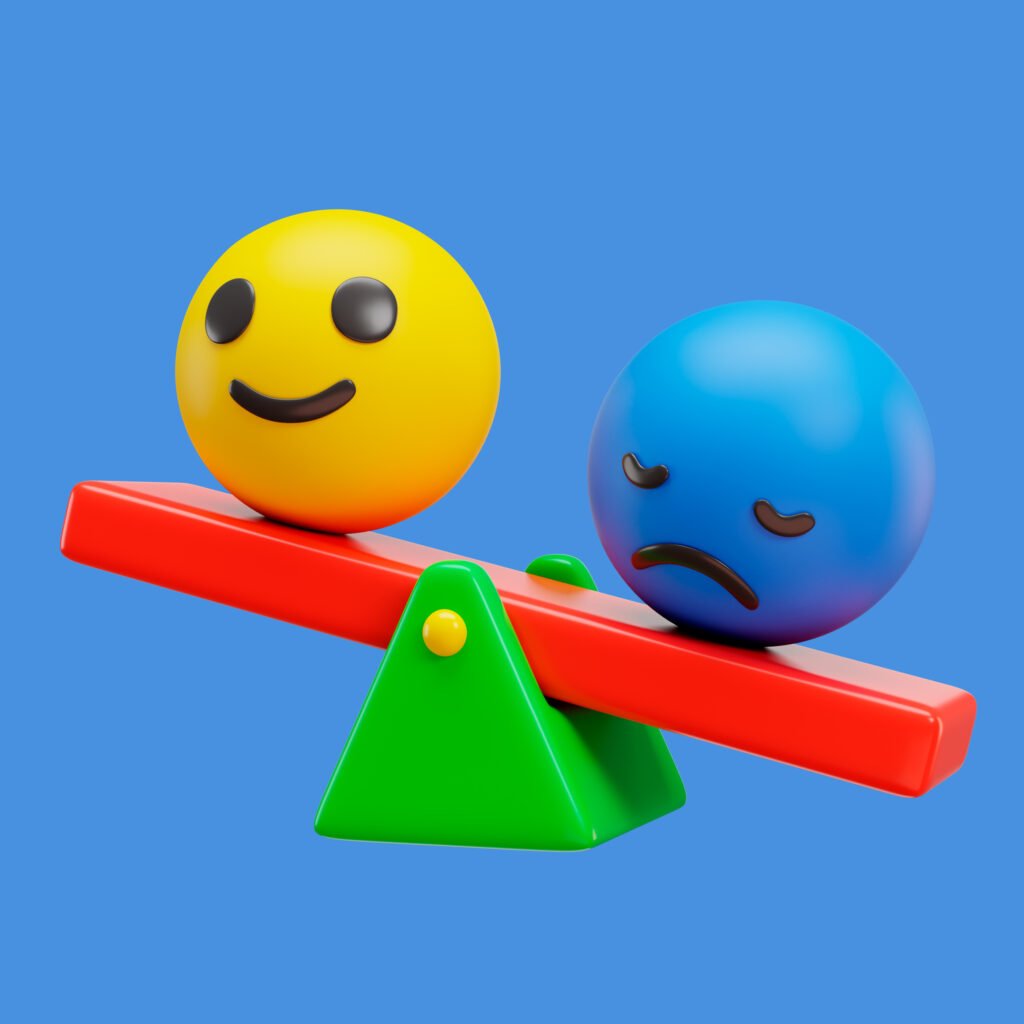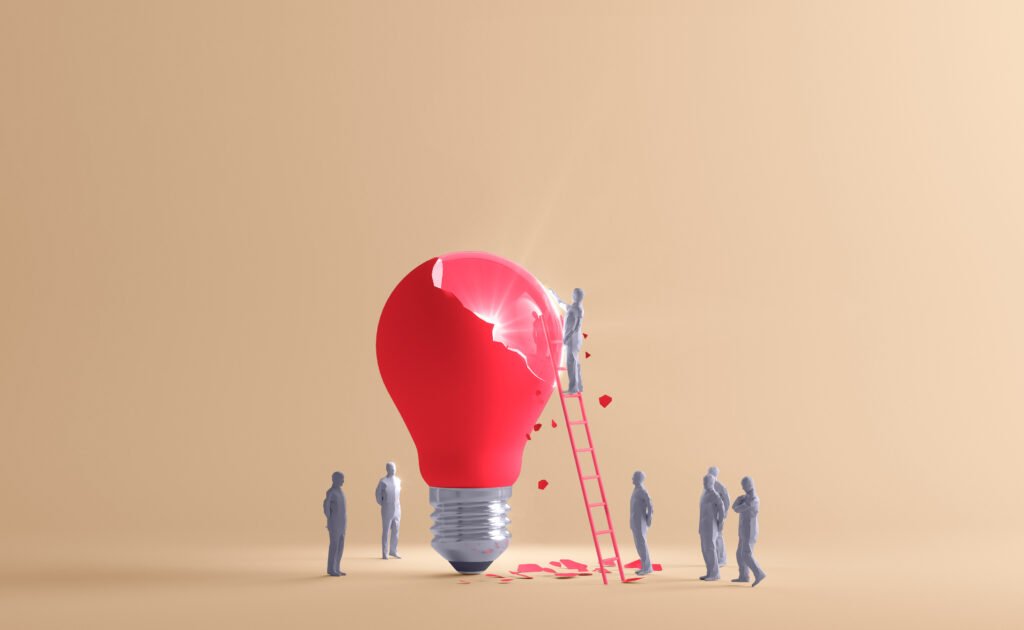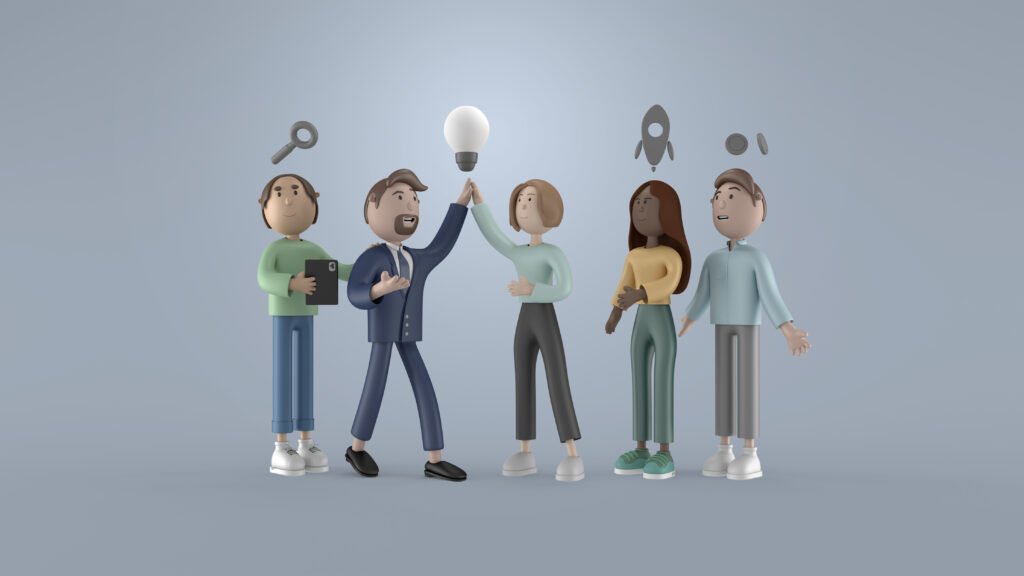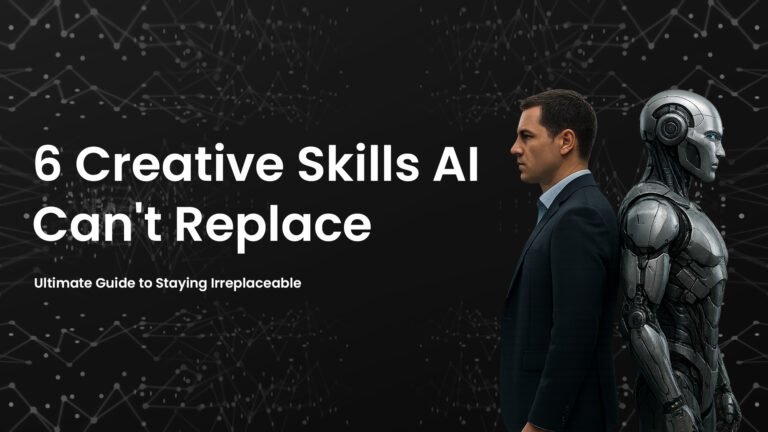The rise of artificial intelligence has sent shockwaves through the creative industry. Everywhere you look, there’s a new AI tool promising to revolutionize design, writing, marketing, or strategy. But here’s what the headlines won’t tell you: there are specific creative skills AI can’t replace—and mastering them is your ticket to long-term career success.
I’ve been working in the creative field for over a decade, and I’ve witnessed AI transform from a curiosity to an everyday tool. Yet, despite all the automation and algorythms, I’ve noticed something fascinating: the most successful professionals aren’t the ones fighting against AI. They’re the ones who understand which creative skills AI can’t replace and double down on developing them.
In this comprehensive guide, we’ll explore six essential creative skills AI can’t replace, why they matter more than ever, and how you can develop them to future-proof your career. Whether you’re a designer, copywriter, marketer, strategist, or creative director, these skills will become your competitive advantage in an increasingly automated world.
Understanding Why Creative Skills AI Can’t Replace Are Your Superpower
Before diving into the specific creative skills AI can’t replace, let’s understand the fundamental difference between human and artificial intelligence. AI is incredible at processing data, recognizing patterns, and executing predefined tasks with remarkable speed and accuracy. But it lacks something crucial: consciousness, genuine human experience, and the ability to truly understand context beyond data points.
The creative skills AI can’t replace are deeply rooted in our humanity—our lived experiences, our ability to feel and connect emotionally, our capacity to imagine things that have never existed, and our understanding of complex social and cultural dynamics. These aren’t just “soft skills” anymore; they’re becoming the hardest skills to find and the most valuable in the marketplace.
According to recent industry reports, companies are actively seeking professionals who can bridge the gap between AI capabilities and human insight. The creative skills AI can’t replace are exactly what employers are willing to pay premium rates for because they drive real business results that algorithms simply cannot deliver.
1. Strategic Thinking & Problem Solving: The Ultimate Human Advantage
When we talk about creative skills AI can’t replace, strategic thinking and problem solving sit at the top of the list. This isn’t just about finding solutions—it’s about identifying the right problems to solve in the first place.
Why AI Struggles with True Strategic Thinking
AI can analyze millions of data points and suggest solutions based on historical patterns. It can tell you what worked before, but it fundamentally cannot grasp the nuanced context that drives meaningful strategy. AI doesn’t understand the subtle shifts in cultural sentiment, the unspoken tensions in a market, or the complex web of human motivations that inform strategic decisions.
Think about it this way: AI might analyze your competitor’s viral campaign and recommend you do something similar. But a human strategist digs deeper—they ask why it went viral, what cultural moment it captured, how the landscape has shifted since then, and what underlying customer need it fulfilled. That’s the difference between copying tactics and developing strategy.

The Components of Strategic Thinking
Real strategic thinking involves several interconnected abilities:
Systems Thinking: Understanding how different elements of a business or campaign influence each other. When you change one variable, what ripple effects occur? AI can model this to some extent, but it can’t account for human irrationality, cultural shifts, or unexpected market dynamics.
Contextual Intelligence: Knowing when to apply which strategy based on dozens of subtle contextual factors. The same approach that worked for one brand might completely fail for another, and understanding why requires human judgment.
Future Scenario Planning: Imagining multiple possible futures and preparing for them. While AI can extrapolate trends, it cannot imagine genuinely novel scenarios or black swan events that haven’t happened before.
Root Cause Analysis: Moving past symptoms to identify underlying issues. AI might tell you your conversion rate dropped, but it takes human insight to understand the real reason—maybe it’s not your landing page but a shift in customer trust due to a competitor’s scandal.
How to Develop Your Strategic Thinking Skills
Want to strengthen this creative skill AI can’t replace? Here’s what actually works:
- Practice asking “why” five times: For any problem, ask why five times to get to the root cause
- Study failures intensely: Learn more from what didn’t work than what did
- Connect dots across industries: The best strategic insights often come from applying lessons from one field to another
- Balance data with intuition: Use analytics as input, not as the answer
- Play strategic games: Chess, Go, and complex strategy games actually build these mental muscles
- Seek diverse perspectives: Your strategy is only as good as the viewpoints you consider
The most successful strategists I know have something AI will never have: the ability to sense what’s coming before the data shows it. They read the room, understand human nature, and make bold bets based on insight, not just information.
Also read: The Ultimate Guide to AI Automation Tools for Content Creators
2. Emotional Intelligence & Empathy: The Heart of Human Creativity
Among all the creative skills AI can’t replace, emotional intelligence and empathy might be the most fundamentally human. AI can detect emotions through sentiment analysis and facial recognition, but it cannot feel them. And that experiential gap makes all the difference.
The Unbridgeable Gap in Emotional Understanding
AI processes emotions as data points—positive sentiment, negative sentiment, neutral. But human emotions are infinitely more complex. They’re layered, contradictory, contextual, and deeply personal. The same words can mean entirely different things depending on tone, relationship, history, and a thousand other factors that no algorithm can fully grasp.
Consider what happens when you watch a powerful commercial that brings tears to your eyes. That emotional response didn’t come from an algorithm optimizing for engagement metrics. It came from a creative person who understood vulnerability, hope, loss, or joy at a visceral level—someone who knew exactly which emotional buttons to push and why.

Why Emotional Intelligence Is Non-Negotiable
In creative work, emotional intelligence and empathy allow you to:
Anticipate Emotional Responses: Before you launch anything, you can feel how your audience will react. Not just think—actually feel it in your gut because you understand their fears, desires, and pain points.
Build Authentic Connections: Whether with clients, team members, or audiences, emotional intelligence lets you forge genuine relationships built on trust and mutual understanding.
Navigate Difficult Conversations: When tensions rise or conflicts emerge, emotional intelligence helps you de-escalate, find common ground, and move forward productively.
Create Resonant Work: The difference between content that gets scrolled past and content that gets shared comes down to emotional resonance. You need to feel your audience’s emotions to create work that touches them.
Read Between the Lines: Clients often can’t articulate what they truly need. Emotional intelligence helps you hear what’s unsaid and address the real concern, not just the stated request.
Developing Your Emotional Intelligence
This creative skill AI can’t replace grows through intentional practice:
- Practice active listening: Focus entirely on understanding, not on formulating your response
- Seek feedback about your impact: Ask people how you make them feel, not just what they think
- Expand your emotional vocabulary: The more precisely you can name emotions, the better you understand them
- Put yourself in uncomfortable situations: Growth happens at the edge of your comfort zone
- Journal about emotional experiences: Reflection deepens emotional awareness
- Consume diverse stories: Books, films, and art from different cultures expand your emotional range
- Pay attention to non-verbal cues: Most emotional communication happens beyond words
I’ve seen incredibly talented creatives struggle because they lacked emotional intelligence. And I’ve seen moderately skilled professionals excel because they understood people. In creative work, emotional intelligence often matters more than technical skill.
3. Original Creativity & Conceptual Ideation: True Innovation
When people ask about creative skills AI can’t replace, original creativity and conceptual ideation usually come to mind first. And they’re right—this is perhaps the most obvious gap between human and artificial intelligence.
How AI “Creates” vs. How Humans Innovate
Let’s be clear about what AI actually does when it “creates.” It identifies patterns in existing data and generates statistically probable combinations of those patterns. It’s remixing, not creating. It can combine elements in novel ways, but it cannot generate truly original concepts that don’t exist anywhere in its training data.
Human creativity works fundamentally differently. We create through:
- Random associations: Your brain makes connections between seemingly unrelated experiences
- Subconscious processing: Ideas emerge from dreams, daydreams, and moments of mental wandering
- Emotional experiences: Personal joy, pain, love, and loss inform creative expression
- Cultural critique: We can step outside our culture to comment on it and imagine alternatives
- Intentional rule-breaking: We understand conventions well enough to violate them purposefully
- Cross-sensory inspiration: A sound might inspire a visual, a taste might spark a story
When Picasso invented Cubism, he wasn’t following any pattern. When someone creates a campaign that redefines an entire industry, they’re doing something AI fundamentally cannot do: generating genuinely novel concepts that have no precedent.

The Power of Conceptual Thinking
Original creativity isn’t just about being different—it’s about conceptual thinking that changes how people see things. It’s about:
Creating New Categories: Sometimes the most creative act is inventing an entirely new way of categorizing or understanding something. AI can only work within existing categories.
Making Intuitive Leaps: The best creative concepts often come from non-linear thinking that skips several logical steps. AI is bound by logic; humans can transcend it.
Embracing Productive Chaos: Human creativity often thrives in ambiguity and chaos—situations where there’s no “right answer” in the data. AI needs parameters; humans create despite them.
Also Check: Portfolio
Cultivating Original Creativity
To develop this creative skill AI can’t replace:
- Embrace boredom regularly: Your most original ideas often come when your mind wanders aimlessly
- Maintain diverse interests: The best creative insights come from combining ideas across fields
- Question every assumption: Ask “why does it have to be this way?” about everything
- Study what doesn’t work: Understanding failures teaches you more than studying successes
- Practice divergent thinking: Generate 100 ideas before judging any of them
- Seek inspiration outside your industry: Cross-pollination creates breakthrough innovation
- Allow for messy exploration: Not every creative session needs a clear goal
- Trust your weird ideas: The concepts that feel risky are often the most original
I’ve noticed that the creatives who stay most relevant are those who consistently produce truly original thinking. They’re not just good at their craft—they’re creating entirely new approaches that others haven’t imagined yet.
4. Personal Taste & Creative Judgment: The Curator’s Invaluable Eye
Here’s a creative skill AI can’t replace that often gets overlooked: personal taste and creative judgment. In a world where AI can generate thousands of options instantly, the ability to recognize excellence, appropriateness, and quality becomes exponentially more valuable.
Why Taste Becomes More Critical with AI
As AI floods the market with content—designs, copy, images, strategies—we’re drowning in options. The problem isn’t generating possibilities anymore; it’s knowing which possibilities are worth pursuing. This is where personal taste and creative judgment become game-changers.
AI can create a hundred logo variations, but it takes human judgment to know which one truly embodies a brand’s essence and will remain timeless. AI can write product descriptions, but a human knows which tone and voice will resonate with a specific audience in a specific cultural moment.
What Informs Creative Judgment
Personal taste isn’t arbitrary—it’s developed through years of experience and exposure:
Deep Cultural Literacy: Understanding references, movements, and the evolution of your craft over time. Knowing what’s been done before and why certain work succeeded or failed.
Contextual Awareness: Recognizing what’s appropriate for different audiences, platforms, and moments. The same creative approach that works for one brand might be completely wrong for another.
Quality Recognition: Developing an internalized sense of excellence that allows you to evaluate work quickly and accurately. This comes from studying thousands of examples across your career.
Balancing Competing Priorities: Knowing how to navigate tensions between aesthetics and function, innovation and familiarity, boldness and appropriateness.
Timing Sensitivity: Understanding not just what’s good, but when it’s right. A brilliant concept at the wrong moment falls flat.
Sharpening Your Critical Eye
To master this creative skill AI can’t replace:
- Study the masters obsessively: Understand why certain work is considered excellent
- Develop articulate critique: Practice explaining what works and what doesn’t with specific reasons
- Build a swipe file of excellence: Curate examples of work that represents your quality standards
- Expose yourself to diverse quality levels: See bad work and good work to calibrate your judgment
- Trust your gut reactions: Learn to notice when something feels off even if you can’t immediately explain why
- Seek mentorship: Learn from people whose taste you respect
- Review your past judgments: Look back at what you greenlit or rejected and analyze the outcomes
In my experience, clients don’t just want options—they want someone who can confidently say “This is the one” and articulate why. That’s judgment, and it’s profoundly human.
5. Storytelling & Communication Skills: The Art of Human Connection
Among the creative skills AI can’t replace, storytelling and communication skills are absolutely fundamental. While AI can string words together or generate images, it fundamentally struggles with the deeper architecture of narrative and the subtle dynamics of persuasive communication.
What Makes Human Storytelling Irreplaceable
Stories are how humans make sense of the world. We don’t just process information—we experience it through narrative. AI can follow story structures, but it cannot understand why certain stories resonate with certain audiences at certain cultural moments.
The difference between a technically correct presentation and one that moves people to action? That requires understanding:
- Audience psychology: What does this specific group care about deeply?
- Emotional journey design: What path will bring them from skepticism to belief?
- Strategic detail selection: Which facts to include, which to omit, and why
- Timing and pacing: When to build tension, when to release it, when to surprise
- Cultural resonance: What references, values, and metaphors will land with this audience

The Many Layers of Effective Communication
Great communication isn’t just about words—it encompasses:
Adaptive Communication: Reading your audience in real-time and adjusting your approach based on their reactions, questions, and energy.
Medium Mastery: Knowing when a story needs to be told through data, when through emotion, when through metaphor, and when through demonstration.
Voice Development: Finding your unique perspective and way of expressing ideas that sets you apart from everyone else.
Cultural Navigation: Understanding sensitivities, values, and communication norms across different groups without resorting to stereotypes.
Persuasion Ethics: Knowing how to influence effectively while maintaining integrity and avoiding manipulation.
Mastering Storytelling Skills
To develop this creative skill AI can’t replace:
- Study narrative structure across all media: Film, literature, journalism, podcasts—each teaches different lessons
- Practice telling the same story multiple ways: See how different approaches land with different audiences
- Find the universal in the specific: The most powerful stories connect individual experiences to broader truths
- Develop your authentic voice: Stop imitating others and find your own way of communicating
- Record yourself: Watching or listening to your communication reveals blind spots
- Practice active listening: The best storytellers are also the best listeners
- Experiment fearlessly: Try different formats, tones, and structures to expand your range
I’ve seen countless AI-generated presentations that check all the boxes but inspire no one. The presentations that drive action always have a human storyteller who shaped the narrative with intention, insight, and soul.
6. Client Partnership & Relationship Building: The Human Touch That Matters
Finally, client partnership and relationship building represents one of the most valuable creative skills AI can’t replace in professional settings. While chatbots can handle customer service tickets, the deep, trust-based partnerships that drive successful creative outcomes require genuine human connection.
Why Relationships Trump Transactions
Creative work is messy, subjective, and often ambiguous. Success requires more than executing tasks—it requires partnership that can navigate:
Unstated Needs: Often clients don’t fully understand or can’t articulate what they actually need. Strong relationships allow you to dig deeper and uncover the real challenge.
Organizational Politics: Understanding internal dynamics, competing agendas, and power structures helps you navigate complex client organizations effectively.
Trust Through Vulnerability: The best work happens when both parties can be honest about concerns, limitations, and failures without fear of relationship damage.
Expectation Management: Balancing what clients want, what they need, and what’s actually possible requires ongoing relationship navigation.
Collaborative Problem-Solving: When things go wrong (and they will), strong relationships turn problems into opportunities for deeper partnership.
The Foundation of Strong Partnerships
Effective client partnership involves mastering:
Deep Listening: Hearing not just what’s said but what’s implied, what’s worried about, what’s hoped for. This requires full presence and genuine curiosity.
Trust Building: Consistently following through on commitments, being honest even when it’s uncomfortable, and demonstrating competence over time.
Conflict Navigation: Addressing disagreements directly but constructively, finding win-win solutions, and strengthening relationships through challenges.
Cultural Intelligence: Adapting your communication style, pacing, and approach to different people and organizational cultures.
Long-Term Thinking: Making decisions that prioritize relationship health over short-term gains or ego protection.
Emotional Regulation: Managing your own reactions while honoring others’ emotions creates psychological safety.
Building Relationship Skills
To develop this creative skill AI can’t replace:
- Prioritize face-to-face interactions: Video or in-person time builds trust faster than email
- Follow up consistently: Small touchpoints maintain relationships between projects
- Share credit and take responsibility: Be generous with recognition, quick to own mistakes
- Learn their business deeply: Understand your clients’ industries, challenges, and opportunities
- Be fully present: Put away devices and give people your complete attention
- Develop cultural competency: Learn about different communication styles and adapt accordingly
- Practice vulnerability: Share your own uncertainties and challenges appropriately
The most successful creatives I know aren’t just talented—they’re trusted advisors who understand their clients’ businesses, challenges, and aspirations at a level that creates true partnership. That depth of relationship cannot be automated, replicated, or replaced by any AI tool.
How These Creative Skills AI Can’t Replace Work Together
Here’s what’s powerful: these creative skills AI can’t replace don’t exist in isolation. They compound and amplify each other:
- Strategic thinking improves when combined with emotional intelligence (understanding human motivations)
- Original creativity becomes more powerful with personal taste (knowing which ideas are worth pursuing)
- Storytelling is enhanced by empathy (understanding what resonates emotionally)
- Client relationships deepen through strategic thinking (delivering real business value)
Your unique combination of these skills, informed by your specific experiences and perspective, creates a professional signature that no one else can replicate—and certainly no AI can match.
Actionable Steps to Future-Proof Your Career
Understanding creative skills AI can’t replace is valuable, but implementation is everything. Here’s your roadmap:
Step 1: Conduct an Honest Skills Audit
Rate yourself 1-10 on each of these six creative skills AI can’t replace:
- Strategic thinking & problem solving
- Emotional intelligence & empathy
- Original creativity & conceptual ideation
- Personal taste & creative judgment
- Storytelling & communication skills
- Client partnership & relationship building
Identify your top two strengths and bottom two opportunities. Be brutally honest.
Step 2: Set Specific Development Goals
For each skill you want to improve, set a concrete goal. Not “get better at strategy” but “analyze three industry disruptions this month and identify the strategic patterns.”
Step 3: Create Learning Systems
Build regular practices into your schedule:
- Weekly time for strategic thinking (no devices, just thinking)
- Monthly feedback sessions on your emotional intelligence
- Daily creative practice (even just 15 minutes)
- Quarterly review of work you’ve judged well and poorly
- Regular client check-ins focused on relationship, not just projects
Step 4: Seek High-Quality Feedback
Find mentors, peers, or coaches who excel in the creative skills AI can’t replace that you want to develop. Regular feedback accelerates growth.
Step 5: Use AI Strategically
Let AI handle the routine, repeatable tasks so you can invest more energy into developing these uniquely human creative skills AI can’t replace. AI should free you up, not replace you.
The Competitive Advantage of Being Irreplaceably Human
Here’s the truth: AI isn’t going away. It’s getting better, faster, and more capable every day. But that’s actually good news for people who master the creative skills AI can’t replace.
As AI handles more tactical work, these human skills become more valuable—not less. Companies don’t need more people who can execute templates. They need strategists who can see around corners, empathetic communicators who can forge real connections, original thinkers who can imagine new possibilities, taste-makers who can curate excellence, storytellers who can move people, and relationship builders who can navigate complexity.
That’s where the value is. That’s where careers are built. That’s where you become irreplaceable.
Final Thoughts: Your Uniquely Human Advantage
The future of creative work isn’t humans versus AI—it’s humans with AI, where the creative skills AI can’t replace become your primary value proposition. By mastering strategic thinking and problem solving, emotional intelligence and empathy, original creativity and conceptual ideation, personal taste and creative judgment, storytelling and communication skills, and client partnership and relationship building, you position yourself as fundamentally irreplaceable.
These creative skills AI can’t replace aren’t just professional assets—they’re what make creative work meaningful. They’re what allow you to create work that matters, that changes minds, that drives real impact in the world.
The automation revolution isn’t a threat—it’s an opportunity. An opportunity to focus on what makes you human, what makes your work unique, and what makes you valuable in ways no algorithm ever will be.
Your challenge isn’t to compete with AI. Your challenge is to become more deeply, authentically, skillfully human in your creative work. Start today. Pick one of these creative skills AI can’t replace and commit to strengthening it this month. Your future self will thank you.
The question isn’t whether AI will change creative work—it already has. The real question is: what will you do to ensure the creative skills AI can’t replace become your superpower?
Subscribe for Newsletter

